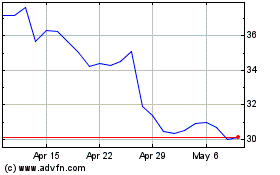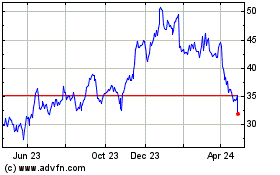Intel Announces 5G Modem Chip
January 04 2017 - 6:57PM
Dow Jones News
By Ted Greenwald
Intel Corp. on Wednesday announced its first communications chip
for the fifth-generation cellular standard known as 5G, a bid to
capture some of the smartphone market that has eluded it as telecom
carriers roll out compatible services in coming years.
The company expects to make the 5G Modem available in limited
quantities in the second half of 2017 and envisions its use in
cars, home networks, and mobile devices.
Intel's announcement follows Qualcomm Inc.'s October
announcement of a 5G modem, also expected to be available in
limited quantities in the latter half of the year.
Widespread 5G services are still well in the future.
Telecommunications industry groups are hammering out the technical
specification. Verizon Communications has discussed rolling out a
5G offering in the coming year, and South Korean telecom carriers
are expected to launch 5G-class services in time for the Winter
Olympics in February 2018. However, most telecom carriers expect to
launch such services in 2020.
Modem chips manage cellular connections, while processor chips
handle calculations involved in running smartphone apps. Intel has
struggled to gain a foothold in the market for both kinds of
chips.
The forthcoming Intel 5G modem is expected to deliver data rates
exceeding 5 gigabits per second -- roughly 100 times faster than
peak speeds claimed by most networks that use the fourth-generation
technology called LTE -- to manage communications among the
Internet of Things that purportedly will flood cell networks with
data from what the company estimates will be 50 billion connected
devices. Intel said the new unit would pair with its existing LTE
modems for devices that require access to both 4G and 5G
networks.
5G connectivity is part of Intel's automotive platform, also
announced Wednesday, which includes hardware and software. The
company expects fast, high-capacity connections will be necessary
for the advent of self-driving cars that make snap decisions about
how to behave by gathering information about their surroundings and
sending it to the cloud for processing.
Modem chips have become a priority for Intel. The company is
eager to reduce its dependence on selling processors for the
slowing personal computer market, and for years focused largely on
pushing its processors into smartphones. But nearly all handset
makers use processors from companies that license technology from
ARM Holdings PLC, initially because of power consumption advantages
and now mainly because they can choose between many chip
suppliers.
At the same time, Intel has failed to gain much traction in
cellular modem chips for smartphones, where Qualcomm is the biggest
supplier. One bright spot for Intel's prospects in that market is
Apple Inc., which replaced Qualcomm's modem chips with Intel's in
some iPhone 7 handsets.
Write to Ted Greenwald at Ted.Greenwald@wsj.com
(END) Dow Jones Newswires
January 04, 2017 18:42 ET (23:42 GMT)
Copyright (c) 2017 Dow Jones & Company, Inc.
Intel (NASDAQ:INTC)
Historical Stock Chart
From Mar 2024 to Apr 2024

Intel (NASDAQ:INTC)
Historical Stock Chart
From Apr 2023 to Apr 2024
